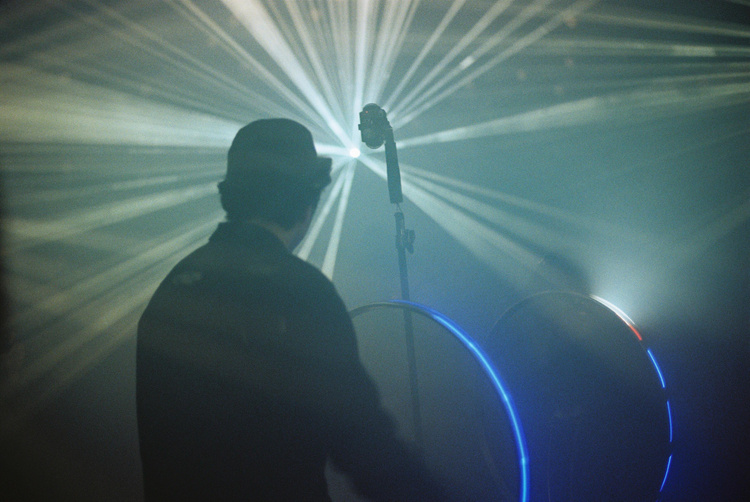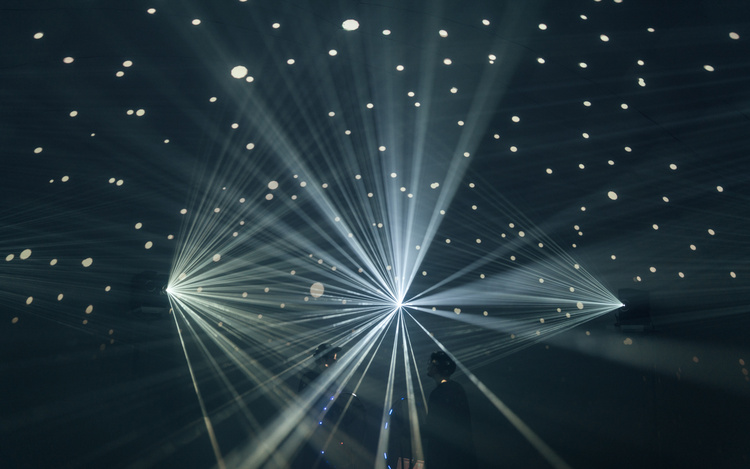Cycling Wheel:DOME
y. 2020
e. Taiwan Contemporary Culture Lab (C-LAB) 空總臺灣當代文化實驗場
“To see that wheel turning was very soothing, very comforting…I enjoyed looking at it, just as I enjoy looking at the flames dancing in a fireplace.”
Marcel Duchamp elaborated how he liked watching audiences spin the wheel of his work Bicycle Wheel in its original exhibition – which audiences could never again do after that first exhibition.
This is the first of Marcel’s ready-made objects, where interaction was welcome in its original character (though it was never touched or spun later); his concept has been borrowed by many artists since then.
"Cycling Wheel: The Orchestra" borrows the idea of Marcel’s Bicycle Wheel, re-activating the wheel into a dynamic and interactive one; here the artist transforms its mechanics into a sound and light controller, and turns these three sets of bicycle wheels into a performative instrument. By embedding audio and lighting in the wheel, the artist creates a dancing flame, just like that described by Marcel Duchamp.
In this DOME version, the wheel become the time-space manipulator, constrcuting the dimension of light and shadow from the memory of Marcel Duchamp.
「看著它[按:指杜象 1913 年的作品《單車輪子》]轉呀轉,那是多心曠神怡的事…我喜歡看著它轉,就像我愛看壁爐裡火焰飛舞一樣。」
杜象說他喜歡看到作品《單車輪子》展出時被觀眾轉動的樣子 - 即使在之後的展覽中觀眾都沒機會再轉動它。《單車輪子》是杜象首件以「現成物」製成的作品:他的本意是鼓勵觀眾與它互動,可惜它卻一直被封印起來,沒有再和觀眾互動過。然而,杜象的概念一直被藝術家們重塑及借用。
《 Cycling Wheel: The Orchestra 》就借用了《單車輪子》的概念,讓被封印的輪子重新運作。藝術家將輪子本身轉化為控制聲音和光影的機器,把兩台單車輪子塑造成表演工具。表演把燈光和聲音和輪子結合,幻化成杜象回憶中那飛舞的火焰。
本次 Dome 版本的演出,輪子成為維度的時空器,將杜象回憶中的火焰交錯出非線性光影維度。
Marcel Duchamp elaborated how he liked watching audiences spin the wheel of his work Bicycle Wheel in its original exhibition – which audiences could never again do after that first exhibition.
This is the first of Marcel’s ready-made objects, where interaction was welcome in its original character (though it was never touched or spun later); his concept has been borrowed by many artists since then.
"Cycling Wheel: The Orchestra" borrows the idea of Marcel’s Bicycle Wheel, re-activating the wheel into a dynamic and interactive one; here the artist transforms its mechanics into a sound and light controller, and turns these three sets of bicycle wheels into a performative instrument. By embedding audio and lighting in the wheel, the artist creates a dancing flame, just like that described by Marcel Duchamp.
In this DOME version, the wheel become the time-space manipulator, constrcuting the dimension of light and shadow from the memory of Marcel Duchamp.
「看著它[按:指杜象 1913 年的作品《單車輪子》]轉呀轉,那是多心曠神怡的事…我喜歡看著它轉,就像我愛看壁爐裡火焰飛舞一樣。」
杜象說他喜歡看到作品《單車輪子》展出時被觀眾轉動的樣子 - 即使在之後的展覽中觀眾都沒機會再轉動它。《單車輪子》是杜象首件以「現成物」製成的作品:他的本意是鼓勵觀眾與它互動,可惜它卻一直被封印起來,沒有再和觀眾互動過。然而,杜象的概念一直被藝術家們重塑及借用。
《 Cycling Wheel: The Orchestra 》就借用了《單車輪子》的概念,讓被封印的輪子重新運作。藝術家將輪子本身轉化為控制聲音和光影的機器,把兩台單車輪子塑造成表演工具。表演把燈光和聲音和輪子結合,幻化成杜象回憶中那飛舞的火焰。
本次 Dome 版本的演出,輪子成為維度的時空器,將杜象回憶中的火焰交錯出非線性光影維度。














Performer
Keith Lam (On Sound Wheel)
Seth Hon (On Light Wheel)
Venue
Taiwan Contemporary Culture Lab (C-LAB)
Photo Courtesy
Taiwan Contemporary Culture Lab (C-LAB)
Keith Lam (On Sound Wheel)
Seth Hon (On Light Wheel)
Venue
Taiwan Contemporary Culture Lab (C-LAB)
Photo Courtesy
Taiwan Contemporary Culture Lab (C-LAB)
演出
林欣傑 (聲音輪子)
韓家俊 (光影輪子)
地點
空總臺灣當代文化實驗場 戰情大樓前廣場
攝影
空總臺灣當代文化實驗場
林欣傑 (聲音輪子)
韓家俊 (光影輪子)
地點
空總臺灣當代文化實驗場 戰情大樓前廣場
攝影
空總臺灣當代文化實驗場